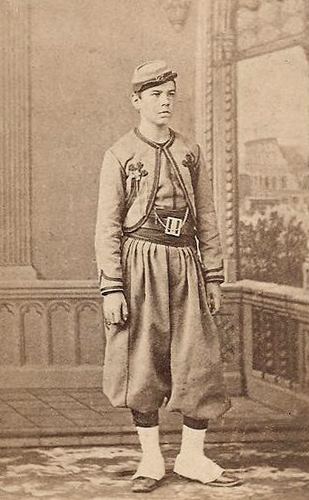 | ||
Active January 1861 – September 1870 Engagements Wars of Italian Unification | ||
The Papal Zouaves (Italian: Zuavi Pontifici) were an infantry force formed in defence of the Papal States.
Contents
Origin
The Zouaves evolved out of a unit formed by Christophe Léon Louis Juchault de Lamoricière in 1860, the Franco-Belgian Tirailleurs. On 1 January 1861 the unit was renamed the Papal Zouaves. The name had been introduced by Frédéric-François-Xavier Ghislain de Mérode. The Almoner became Mgr. Edouard de Woelmont.
International composition
The Zuavi Pontifici were mainly young men, unmarried and Roman Catholic, who volunteered to assist Pope Pius IX in his struggle against the Italian unificationist Risorgimento. They wore a similar style of uniform to that of the French Zouaves but in grey with red trim. A grey and red kepi was sometimes substituted for the North African fez.
All orders were given in French and the unit was commanded by a Swiss Colonel, M. Allet.
Nonetheless, the regiment was truly international, and by May 1868 numbered 4,592 men. At that time the unit was composed of 1,910 Dutch, 1,301 French, 686 Belgians, 157 Romans and Pontifical subjects, 507 Canadians, 1,400 Irish, 87 Prussians, 50 English, 32 Spaniards, 22 Germans from beyond Prussia, 19 Swiss, 14 Americans, 14 Neapolitans, 12 Modenese, 12 Poles, 10 Scots, 7 Austrians, 6 Portuguese, 6 Tuscans, three Maltese, two Russians and one volunteer each from the South Sea Islands, India, Africa, Mexico, Peru and Circassia.
A British volunteer, Joseph Powell, noted in his account of his service with the Papal Zouaves, Two Years in the Pontifical Zouaves that at least three "blacks" and one person from China served in the Zouaves.
Between February 1868 and September 1870 the number of Canadian volunteers, mainly from the francophone and predominantly Catholic province of Quebec, rose to seven contingents numbering some 500 men in total – with a contingent of 114 turning back to Canada because news had reached them of the surrender of the Papal States in September 1870.
The Battle of Mentana
One thousand five hundred Papal Zouaves assisted in the notable Franco/Papal victory at the Battle of Mentana, fought on 3 November 1867 between French-Papal troops and Italian volunteers led by Giuseppe Garibaldi.
In his report to the Pope, the commander of the Papal forces, General Kanzler, praised the elan of the Zouaves, citing a determined bayonet charge as a particular example.
The Zouaves suffered the brunt of the fighting, sustaining 81 casualties in the battle, including 24 killed (the Papal forces suffered only 30 dead in total) and 57 wounded. The official French report of the battle prepared by the French commander, General de Failly, also cited the bravery of the Papal Zouaves. The youngest victim, aged seventeen, was English Zouave Julian Watts-Russel.
The Zouaves are mentioned in Victor Hugo's poem Mentana.
Last days of the Papal States
The Zouaves also played a role in the final engagements against the forces of the newly united Kingdom of Italy in September 1870, in which the Papal forces were outnumbered almost seven to one. The Zouaves fought off enemy lancers on the 13th, withdrew with Papal artillery under heavy fire on the 20th and made preparations for a counterattack against the Garibaldians before being told of the surrender, whereupon they destroyed their weapons.
Several Zouaves were executed or murdered by the Italian forces following the surrender, including a Belgian officer who refused to give up his sword.
Volunteers of the West
After the Capture of Rome by Victor Emmanuel in 1870, the French contingent of the former Papal Zouaves served the government of National Defence in France during the Franco-Prussian War. Renamed as the Volontaires de l'Ouest (Volunteers of the West) but retaining their grey and red Papal uniforms, the Zouaves fought the Prussians and their other German allies outside Orléans, with 15 killed or wounded between 11 and 12 October 1870, and also engaged the enemy at Patay. Numbering about 1,800 men, the experienced former Papal Zouaves fought with distinction at the Battle of Loigny where they lost 216 men while covering the retreat of other French units. The Volontaires were disbanded after the entrance of Prussian troops into Paris.
Monuments
There are a number of monuments to the Papal Zouaves, including a Dutch museum near the Oudenbosch Basilica, the Mass chapel in the Capuchin Crypt and a monument in the Lateran.
